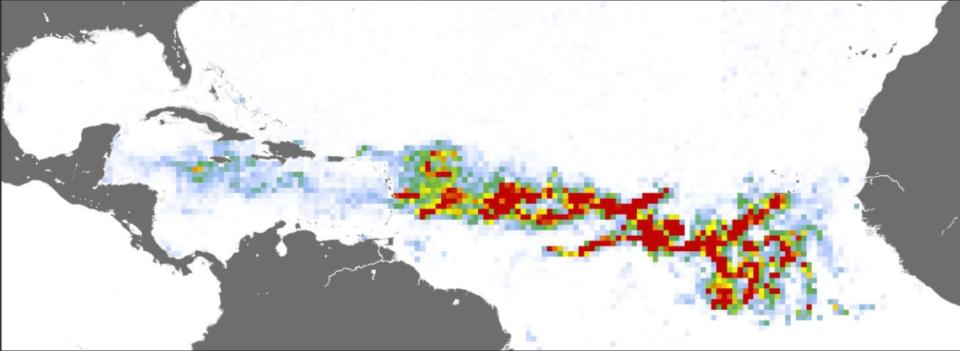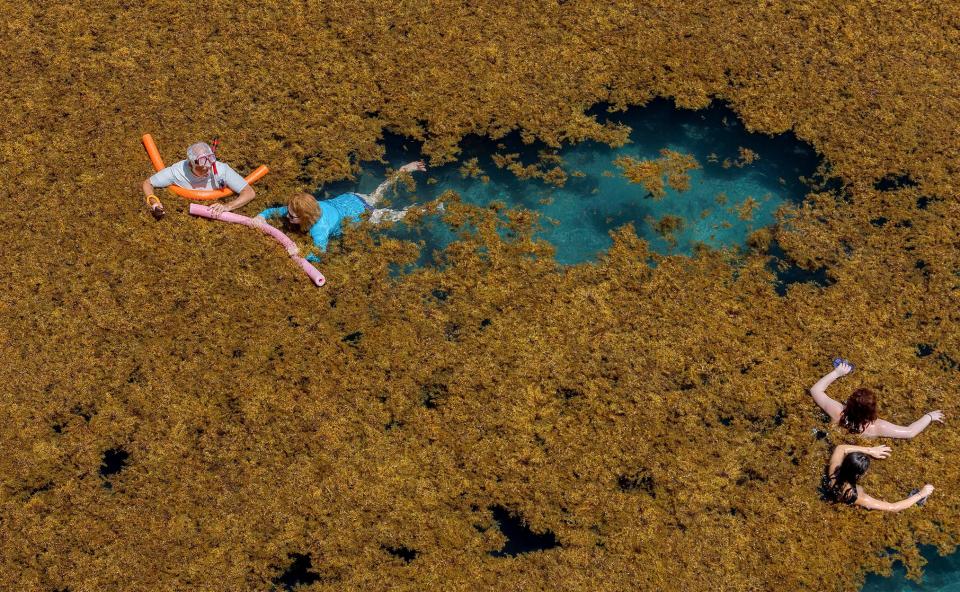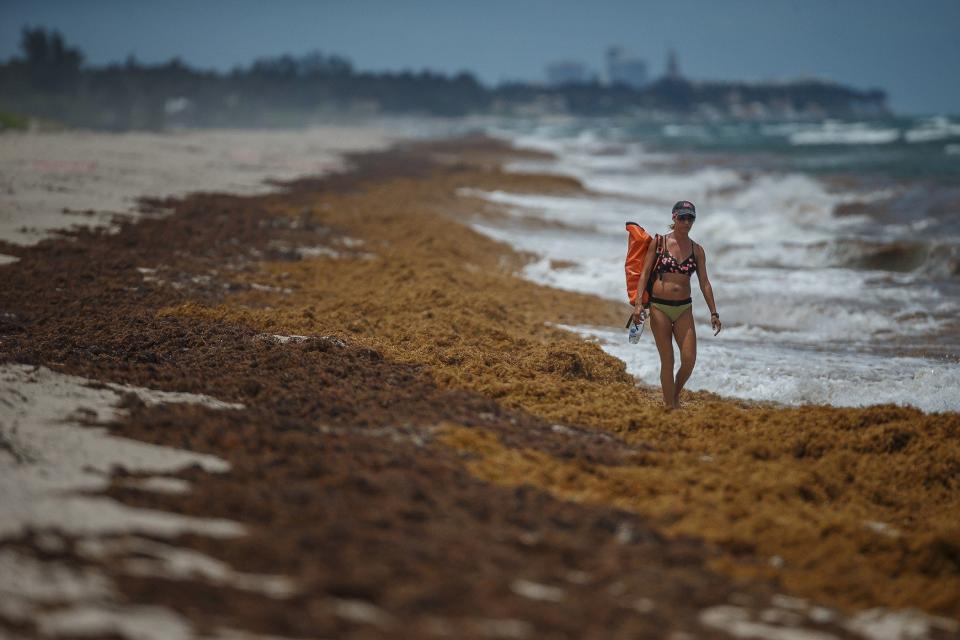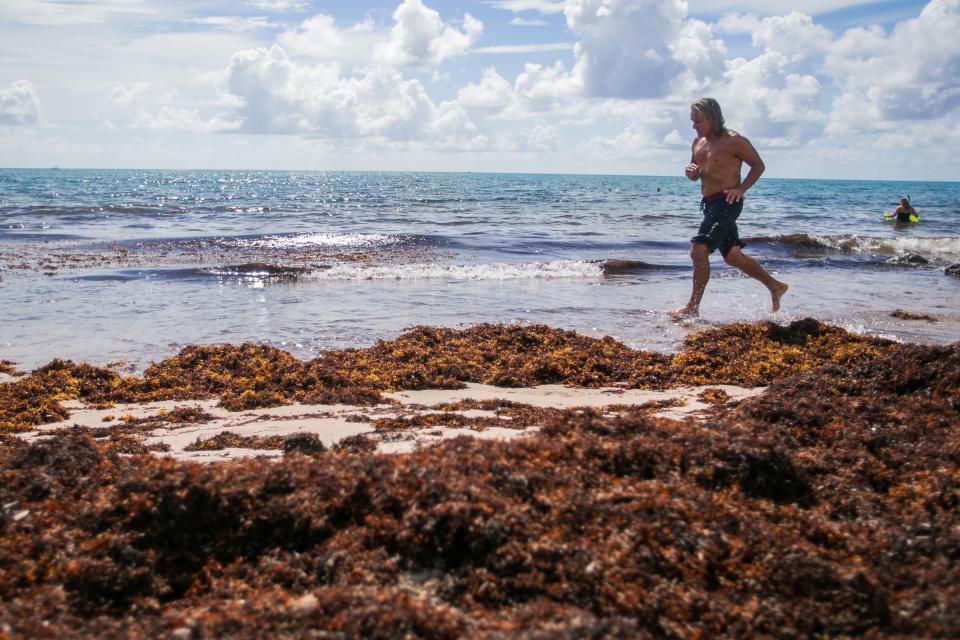A giant sargassum seaweed blob takes aim at Florida
A seething tangle of floating trouble is massing for a potential summer assault on Florida beaches as a vast forest of sargassum grows in record amounts in the Atlantic Ocean.
University of South Florida scientists said January was the second consecutive month that the amount of seaweed doubled, reaching 8.7 million tons, which is enough to fill about 3,000 Olympic size pools.
It also broke the previous January record set in 2018.
“This is very rare in history,” said USF oceanography professor Chuanmin Hu, about the rapid growth. "All we can do now is keep a close eye on what's going on."
Seaweed comes to shore like a horror movie
Sargassum is a lifeline for fish nurseries, hungry migratory birds and sea turtle hatchlings seeking shelter in its buoyant saltwater blooms. But in mass quantities, it chokes life from canals, clogs boat propellers, and is a killjoy at the beach, piling up several feet deep like a rotting bog emitting hydrogen sulfide as it decomposes.
“Our beach could literally be clean at 8 a.m. and three to four hours later a giant mat of sargassum the size of a mall will come in like the blob, like a Stephen King movie,” said Tom Mahady, city of Boynton Beach Ocean Rescue chief. "It's not pleasant for swimmers."

Penalties:Jupiter divers who freed sharks, destroyed angler's gear avoid harshest penalties
Shark bait:Jupiter is hot spot for sharks munching on line-caught fish; now what can be done about it?
Noah's Ark for coral:'Daring' coral rescue as officials attempt to safeguard genetics of Florida reef tract
Winter growth spurt is unusual
Last year was a record-breaker for the total amount of sargassum, with it reaching a peak of 22 million tons in July. Hu said 2023 will be another major sargassum year, possibly surpassing 2022.
It’s too early to know how much seaweed will reach Florida’s beaches, but it has shown up in varying degrees and depths during every major growth year, hitching a ride on the loop current to assail the Keys and areas north from Miami to Jacksonville.
One mystery this year is the proliferation of the sargassum in the winter months when it usually sees its growth spurt in spring and summer, said Hu, noting that his team has not tied warmer water temperatures to larger blooms.

Bird bonanza:Why four nesting shorebirds had Palm Beach County officials jumping for joy
Happy coral:How coral is thriving in a trashy, polluted port thrashed by cruise ships
Amazing discovery in Palm Beach County:Giant manta ray babies and a study that could save a threatened species
'We were gobsmacked':Great hammerhead shark nursery discovered in urban area of Florida
Hu’s Optical Oceanography lab at USF measures the sargassum by satellite and has images dating back decades. He was part of a team of scientists that discovered the world’s largest sargassum bloom in the Atlantic Ocean, dubbing it the Great Atlantic Sargassum belt.
Smoke, Amazon River, cold water upwelling feeds seaweed
A 2019 report on the group's findings pointed to two main culprits for the increase in sargassum — higher nutrient levels in runoff from the Amazon River and when an upwelling in the eastern Atlantic brings cooler water and nutrients from the bottom of the ocean to the surface.
A University of Miami study released the same year found that smoke from African fires — either from those burning wild or burning to clear land — has phosphorus in it that could also be feeding the sargassum after it settles out of the atmosphere.

Florida Atlantic University research professor and algae expert Brian LaPointe said years with large amounts of sargassum build on each other because there is so much seed material to start the next crop.
“It really becomes a problem when it piles up in the mangroves and causes these dead zones,” LaPointe said. “It literally fills manmade canals, coming right up in front of people's homes and surrounding docks.”
LaPointe spoke in September to the Palm Beach Town Council after sargassum piled up several feet deep at the north end of the island south of the Lake Worth Inlet, also known as the Palm Beach Inlet.
Sargassum piles on Palm Beach as high as moguls on a ski slope
“We had moguls of it,” said town councilmember Bobbie Lindsay about the sargassum. “The beach was unusable for much of the summer, it was scratching your thighs, it was just disgusting.”
Lindsay said the decaying seaweed could be smelled several streets away from the beach depending on the wind direction.
"The air was so toxic I couldn't walk down there," Lindsay said.

Palm Beach, like many towns, cleans its public beaches with mechanical raking devices. But during the turtle nesting season from March 1 through Oct. 31, the cleaners have to stay below the high tide line. Sea turtles typically nest above the high tide line so their eggs stay dry. Nests below the high tide line are usually marked by sea turtle monitors so the rakes can avoid them.
While sargassum can help turtle hatchlings once they hit the water, high mounds on the beach are a barrier to them reaching it.
This year the Town of Palm Beach has a contract to either bury the sargassum at the north end of the island or remove it if there is too much to bury. Director of Public Works Paul Brazil said the Florida Fish and Wildlife Conservation Commission and Florida Department of Environmental Protection are working with the town on ways to handle the sargassum during nesting season.
LaPointe suggested using floating barriers to keep the seaweed from coming ashore. More than a mile of floating barrier was placed off the coast of Mexico’s Tulum National Park in August. LaPointe said areas of the Keys are already using it or considering it.
More:Worldwide mystery: What are those things the ocean’s been dumping on Palm Beach?
More:These mysterious 'devices' keep washing up on Florida’s beaches. Scientists are concerned.
The rotten egg smell in the Keys from the decomposing sargassum has prompted at least one online guidebook to have a chapter titled “Why do the Florida Keys smell like sulfur?”
Hu said he’s been called by real estate investors on where best to buy land along Mexico’s Caribbean coastline to avoid sargassum. An airline also asked for his advice when it was deciding its schedule so as not to load up on flights to sargassum-rich areas during tourist season.
“People don’t like it because it’s unsightly,” said Mahady, the Boynton Beach ocean rescue chief. “But you can’t stop it from raining, you can’t stop snow, and you can’t stop seaweed.”
Kimberly Miller is a veteran journalist for The Palm Beach Post, part of the USA Today Network of Florida. She covers real estate and how growth affects South Florida's environment. Subscribe to The Dirt for a weekly real estate roundup. If you have news tips, please send them to kmiller@pbpost.com. Help support our local journalism, subscribe today.
This article originally appeared on Palm Beach Post: Florida beaches could be covered in record seaweed blob this summer


